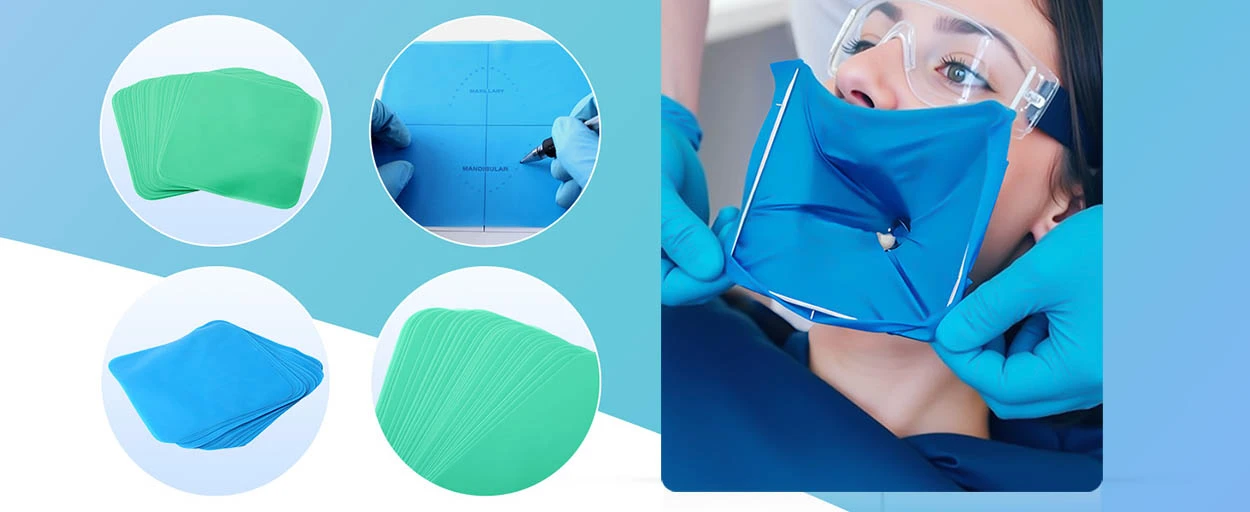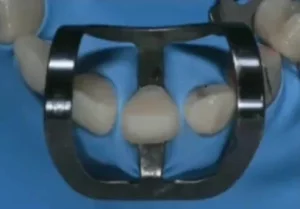During dental procedures, the constant flow of saliva and blood that collects in the operative area can be very disruptive to the dentist. Is there anything that can stop these fluids? Yes, there is a rubber dam. In this article, learn about the materials, uses and many important facts about rubber dam.
1. What is a Rubber Dam?
A rubber dam is also known as a moisture barrier. It is a technique whereby a square piece of fabric is used to isolate the tooth to be treated so that saliva from the mouth does not flow into the dentist’s area. As dental filling materials are used, contamination by saliva or blood can cause filling failure. It is therefore very important to isolate liquids. A rubber dam also separates the water sprayed from the dental instruments from entering the patient’s mouth. This way, Saliva Ejectors and other suction devices do not have to be inserted into the bottom of the patient’s mouth, causing an uncomfortable foreign body sensation that can lead to vomiting.
The use of rubber dam is therefore very important in dental treatment, and the effectiveness of the treatment can be greatly improved by simply using a rubber cloth. The rubber dam consists of: a rubber cloth, a perforator, a clamp, a facebow, and a baffle clamp.
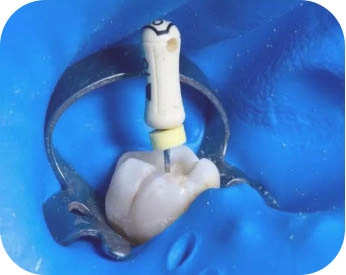
2. Material of Rubber Dam
Natural Latex Material:
- Advantages: high elasticity (tear resistance) and good sealing. Latex rubber dams are ideal if you are performing root canals or fillings that require a strict moisture barrier. Unless the patient is allergic to latex.
- Disadvantage: Latex is allergenic in about 1% to 6% of the population. In this group of patients, latex rubber dams should not be used, even if they offer significant advantages. This can lead to allergic reactions such as contact dermatitis or respiratory symptoms or even more serious complications.
Non-latex Materials:
Common types: silicone, polyurethane (PU), polyisoprene
Properties:
- Polyurethane (PU) rubber dams have good thermal conductivity, no odor, but are less flexible and more costly.
- Silicone/polyisoprene rubber dams are close to latex in flexibility. High elasticity, and low allergy risk, making them more suitable for children or latex allergy sufferers.
3. Rubber Dam Thickness Parameters and Clinical Adaptation
| Thickness (mm) | Applicable Scenario | Advantages & Disadvantages |
|---|---|---|
| 0.15–0.20 | Single tooth isolation, tight contact teeth | Easy to puncture the gingival sulcus, but weaker tear resistance; |
| 0.25–0.30 | Multiple tooth isolation, subgingival defects, or root canal treatment | Stronger moisture isolation, slightly reduced operational flexibility; |
| ≥0.35 | Large area restorations or high bleeding risk surgeries | Ultimate sealing, requires strong clamp fixation |
Note: When children’s teeth are in the developmental stage, excessive pressure should not be applied. Therefore, it is recommended to use a 0.15 – 0.20mm thin non-latex rubber dam to prevent excessive elasticity from damaging the child’s teeth.
4. Clinical Significance of Different Colored Rubber Dams
Patients who have used rubber dams at dental clinics are likely aware that rubber dams come in many colors and scents. These colors and scents are not designed randomly, they all have practical clinical significance.
- Dark-colored Rubber Dams (Green/Blue/Black): Enhance the contrast between the tooth and the rubber sheet, making it easier to identify the edges of cavities and decayed tissue.
- Light-colored Rubber Dams (Yellow/Gray): Superior translucency, suitable for microscope procedures or X-ray imaging.
- Scented Rubber Dams: Improve the patient experience and help alleviate patient anxiety. However, when using scented rubber dams, it is necessary to avoid allergens that may affect sensitive patients.

5. Composition and Key Operations of the Rubber Dam System
After the introduction of the rubber cloth, let’s move on to explore the components of the entire Rubber Dam System.
Core Components
- Rubber Cloth: Latex/non-latex materials, which have been detailed earlier.
- Dam Clamps: Classified by tooth position (e.g., butterfly clamp for anterior teeth, serrated clamp for fixing broken crowns).
- Auxiliary Tools: Puncher (hole size 0.5–2.5mm), frame, dental floss, sealants (for gap repairs).
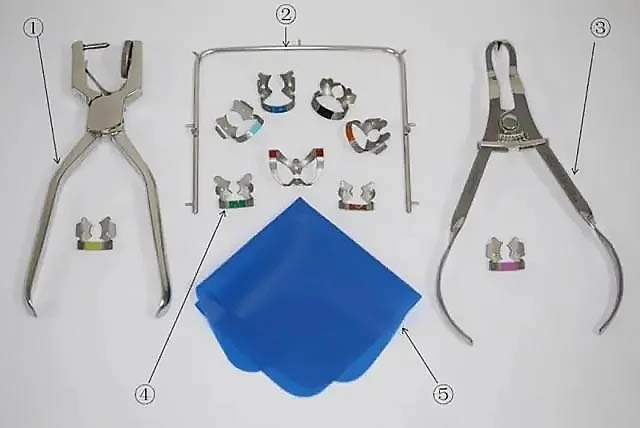
Note: ①Puncher ②Frame ③Dam Clamp ④Butterfly Clamps ⑤Rubber Cloth
Installation Method
- Wing Technique (Posterior Teeth): Use the clamp arms to open the rubber cloth hole, then fit it around the cervical area of the tooth and secure it.
- Rubber Cloth First Technique (Anterior Teeth): First, thread the cloth and then secure the clamp, with dental floss assisting in passing through the contact points.

- After installation, check the gingival margin seal, and use sealants to fill any gaps if necessary.
Precautions
- The edges of the rubber cloth hole must be smooth to prevent tearing. When isolating multiple teeth, maintain a hole distance of ≥2mm to prevent leakage.
- Avoid clamping on the edge of full porcelain crowns to prevent chipping.
- For patients allergic to latex, switch to non-latex rubber cloth.
6. Functions of the Rubber Dam System
The entire rubber dam system was introduced in detail earlier. Next, let us deeply explore the functions of this system.
6.1. The rubber dam system can provide a clear surgical field
For example, during root canal treatment, the rubber dam can isolate the damaged tooth from other parts of the oral cavity. It effectively blocks the seepage of saliva and blood, providing the dentist with a dry and clean operating area. The high contrast of the rubber sheet also allows the dentist to more clearly identify the treatment area, facilitating precise operations.
It can isolate surrounding soft tissues such as gums and buccal mucosa, avoiding visual interference. The rubber dam also fully exposes all surfaces of the tooth to the dentist’s view, aiding the use of dental microscopes.
During root canal treatment, the operating space is extremely narrow. Dentists must maintain high concentration, and prolonged periods easily lead to visual fatigue. At this time, moisture within the mouth and issues with light reflection undoubtedly pose significant challenges to the dentist. However, with the barrier and high contrast provided by the rubber dam, problems with moisture and scattered light reflection cease to exist. This allows the dentist to obtain a clearer and more stable surgical field.
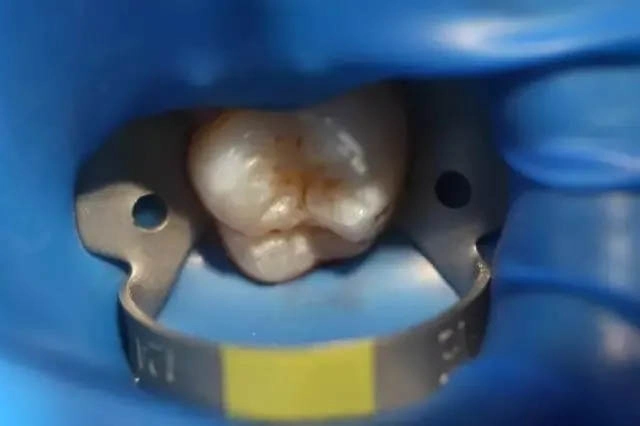
6.2. Prevents aspiration and swallowing accidents
The rubber dam system only exposes the tooth being treated while isolating other parts of the oral cavity. This prevents surgical instruments, such as the coolant spray from high-speed handpieces, from being accidentally aspirated by the patient. It also prevents small surgical instruments from falling into the patient’s mouth and being accidentally swallowed.
For example, see the image below (from a client’s dental clinic). During a patient’s root canal treatment, an endodontic file accidentally fell into the patient’s mouth, was swallowed, and became lodged in the transverse colon. It could only be removed through surgery. Ultimately, the clinic faced a patient complaint and paid substantial compensation. If a rubber dam had been used initially, this problem would not have occurred, because even if the instrument fell accidentally, it would be blocked by the rubber sheet.
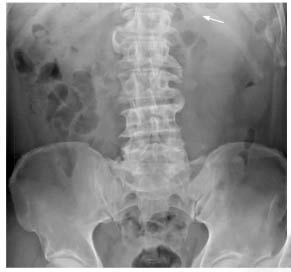
6.3. Prevents accidental injury to the soft tissues of the mouth
Dental drills, polishing brushes, and other instruments are driven by high-speed handpieces and can be very destructive. If these instruments accidentally cross the line while working on a tooth, they can injure the surrounding soft tissues. Rubber dam can act as a cushion to prevent accidental injuries to the soft tissues of the mouth. Sometimes the use of high-volume suction tubes can also accidentally injure the soft tissues, and the rubber dam can also prevent this from happening.
6.4. Improvement of adhesive strength of resin-based restorations.
The rubber dam system provides a better moisture barrier for resin restorations, prosthetic bonding and bracket bonding. This greatly improves the bonding strength and reduces the chance of dislodging the resin material or restoration.
6.5. Preventing Iatrogenic Cross-Infection
As mentioned earlier, the rubber dam is a good barrier to saliva and blood. This minimizes the formation of pathogen droplets and aerosols during treatment. This reduces the spread of pathogens and protects healthcare workers and other patients.
After learning so much about the use of rubber dams, it seems that they are an excellent dental instrument. However, in actual dental treatment, it is not always used because it also has limitations. Next, we will introduce the shortcomings of the rubber dam.
7. Disadvantages of the Rubber Dam System
7.1. Time-consuming replication
The installation and removal of the rubber dam system require a certain level of skill, and considerable time is needed before the procedure to communicate with the patient and adjust the dam to the optimal position. This leads to a longer overall treatment time, which means higher costs. Some patients may feel that the time and effort involved are unnecessary.
7.2. Reduced comfort
This varies from person to person. Some patients feel reassured and comfortable because the rubber dam prevents external things from entering the mouth. However, there are also some patients who dislike the feeling of the fixed clamps and the rubber cloth restricting their mouth. In severe cases, it can even affect the patient’s breathing, causing strong discomfort.
7.3. Technical thresholds
In fact, although the rubber dam has been included in the exam for dentists, many dentists are not fully proficient in using the rubber dam system. If the technique is not mastered, forcing its use can make the patient even more uncomfortable.
7.4. Additional costs
The rubber dam and its associated components, including clamps, punchers, etc., require an additional cost. Some patients may not be able to accept this additional cost.
8. Conclusion
Rubber dam is a protective shield for dental treatment and can make dental visits safer and more secure. It is a “magic bullet” that protects both the patient and the doctor and improves the outcome of the dental treatment. However, the rubber dam also has its limitations, and the treating dentist should communicate with the patient and comprehensively consider whether to apply the rubber dam system based on the patient’s oral and dental condition.

